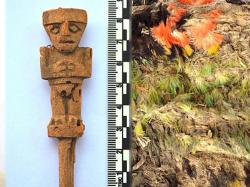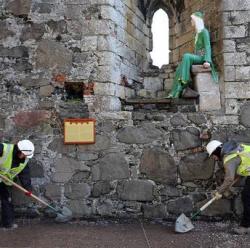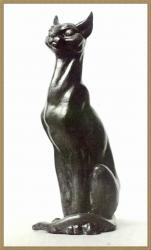INSTITUT SUPERIEUR D'ANTHROPOLOGIE
INSTITUTE OF ANTHROPOLOGY
ONLINE COURSES / COURS A DISTANCE
SPRING TERM : APRIL 2014
REGISTER NOW
PEROU –  Pachacamac - Small wooden carving and feather-covered cloth were found at archaeological site near Lima.The Pachacamac archaeological site, located about 40 kilometers southeast of Lima, has yielded some new finds. According to Peru21, archaeologists working at the site have found two relatively well-preserved artifacts at the site: a small wooden carving depicting a female figure and a cloth covered with brightly-colored feathers. Peru21 reports that the pieces were found by specialists who work at the Pachacamac site museum. The objects were discovered in the area of the site called Pilgrims’ Plaza. The wooden figurine measures 8.5 centimeters long, and bears the likeness of a standing woman with her hands resting on her chest. The feathered cloth is 54 centimeters long and 10 centimeters wide, and features orange, green, black, and other colors of plumes. The Pachacamac sanctuary is a religious and administrative center, constructed slowly over centuries by several different cultures, including the Huari and Ichma. The Ichma were later conquered by the expanding Inca empire, and Pachacamac was absorbed into the Inca infrastructure. Most of the buildings in the complex were constructed between 800 and 1450 AD. According to Peru21, excavations at Pachacamac have been restarted as part of the Qapaq Ñan project.
Pachacamac - Small wooden carving and feather-covered cloth were found at archaeological site near Lima.The Pachacamac archaeological site, located about 40 kilometers southeast of Lima, has yielded some new finds. According to Peru21, archaeologists working at the site have found two relatively well-preserved artifacts at the site: a small wooden carving depicting a female figure and a cloth covered with brightly-colored feathers. Peru21 reports that the pieces were found by specialists who work at the Pachacamac site museum. The objects were discovered in the area of the site called Pilgrims’ Plaza. The wooden figurine measures 8.5 centimeters long, and bears the likeness of a standing woman with her hands resting on her chest. The feathered cloth is 54 centimeters long and 10 centimeters wide, and features orange, green, black, and other colors of plumes. The Pachacamac sanctuary is a religious and administrative center, constructed slowly over centuries by several different cultures, including the Huari and Ichma. The Ichma were later conquered by the expanding Inca empire, and Pachacamac was absorbed into the Inca infrastructure. Most of the buildings in the complex were constructed between 800 and 1450 AD. According to Peru21, excavations at Pachacamac have been restarted as part of the Qapaq Ñan project.
http://www.peruthisweek.com/news-archaeologists-find-new-artifacts-at-pachacamac-sanctuary-near-lima-peru-102423
ROYAUME UNI–  Carrickfergus - An archaeological excavation at Ireland's best-preserved Anglo Norman castle has been extended after the discovery of a secret tunnel.xperts from Queen's University had been commissioned to spend three weeks conducting exploratory digs at Carrickfergus Castle in a bid to find out more about the 800-year-old fortification on the shores of BelfastLough. Built in 1177 by Anglo Norman knight John de Courcy soon after his invasion of Ulster, the castle lies on the stretch of coastline where King William III landed in Ireland before the Battle of the Boyne in 1690. Its history includes sieges by King John in 1210 and Edward Bruce in 1315 and capture by the French under Captain Francois Thurot in 1760. The castle was used by the British Army until 1928 and it housed air-raid shelters during the Second World War. Mr Durkan said the excavations had already revealed new information about how the castle was used over the centuries, particularly its use in the Victorian period. He said archaeologists were surprised to discover parts of a 19th-century tunnel extending into the area where the medieval Great Hall once stood.;;The Victorian features have disturbed earlier deposits and are allowing archaeologists to dig a little deeper into the site and uncover substantial remains of what look like medieval walls. Mr Durkan said he was extending the dig to the end of March so these uncovered features could be more fully recorded.
Carrickfergus - An archaeological excavation at Ireland's best-preserved Anglo Norman castle has been extended after the discovery of a secret tunnel.xperts from Queen's University had been commissioned to spend three weeks conducting exploratory digs at Carrickfergus Castle in a bid to find out more about the 800-year-old fortification on the shores of BelfastLough. Built in 1177 by Anglo Norman knight John de Courcy soon after his invasion of Ulster, the castle lies on the stretch of coastline where King William III landed in Ireland before the Battle of the Boyne in 1690. Its history includes sieges by King John in 1210 and Edward Bruce in 1315 and capture by the French under Captain Francois Thurot in 1760. The castle was used by the British Army until 1928 and it housed air-raid shelters during the Second World War. Mr Durkan said the excavations had already revealed new information about how the castle was used over the centuries, particularly its use in the Victorian period. He said archaeologists were surprised to discover parts of a 19th-century tunnel extending into the area where the medieval Great Hall once stood.;;The Victorian features have disturbed earlier deposits and are allowing archaeologists to dig a little deeper into the site and uncover substantial remains of what look like medieval walls. Mr Durkan said he was extending the dig to the end of March so these uncovered features could be more fully recorded.
http://www.belfasttelegraph.co.uk/news/local-national/northern-ireland/carrickfergus-castle-dig-extended-30069136.html
FRANCE –  Olonne sur Mer -Les pièces en bois découvertes dans les marais d'Olonne-sur-Mer en 2002 et 2013 appartiennent-ils à un moulin à vent construit par les Vikings aux Xe et XI siècles ? C'est en tout cas l'hypothèse que fait l'Association vendéenne de vidéo et d'archéologie sous-marine, après la deuxième mise au jour d'éléments immergés. Des études de datation au carbone 14, réalisées par la commune en 2012, ont permis de situer entre 952 et 1 032 les pièces de bois découvertes. Pour l'instant, la datation des bois laisse perplexe l'association sur une présence aussi tardive des Vikings ici. "Mais si cette hypothèse se confirmait, il s'agirait, à notre connaissance, des vestiges du plus ancien moulin à vent européen découvert à ce jour", assure l'association.
Olonne sur Mer -Les pièces en bois découvertes dans les marais d'Olonne-sur-Mer en 2002 et 2013 appartiennent-ils à un moulin à vent construit par les Vikings aux Xe et XI siècles ? C'est en tout cas l'hypothèse que fait l'Association vendéenne de vidéo et d'archéologie sous-marine, après la deuxième mise au jour d'éléments immergés. Des études de datation au carbone 14, réalisées par la commune en 2012, ont permis de situer entre 952 et 1 032 les pièces de bois découvertes. Pour l'instant, la datation des bois laisse perplexe l'association sur une présence aussi tardive des Vikings ici. "Mais si cette hypothèse se confirmait, il s'agirait, à notre connaissance, des vestiges du plus ancien moulin à vent européen découvert à ce jour", assure l'association.
http://www.ouest-france.fr/patrimoine-decouverte-archeologique-1980197
EGYPTE –  Hierakonpolis - Humans and cats have been enjoying, or at least tolerating, one another’s company for a very long time. But when, exactly, did we start hanging around together?Newly published research suggests it was way back in the 4th century B.C.E. “It is clear that there was a close relationship with humans that predate the oldest accepted evidence for domestic cat in Egypt by almost two millennia,” writes a research team led by Wim Van Neer of the Royal Belgian Institute of Natural Sciences. Its paper is published in the Journal of Archaeological Science. As the researchers note, conventional wisdom has long held that cats were first domesticated in ancient Egypt somewhere around 1950 B.C.E. A few years ago, however, a discovery was made while excavating an ancient cemetery at Hierakonpolis, a sizable city that predates the pyramids. A group burial from around 3700 B.C.E. included a young adult jungle cat featuring a healed bone fracture. This indicates “the animal had been tended to for several weeks prior to its sacrifice,” which means it was a domestic cat—at least for the final stage of its life. The new paper describes an even more intriguing finding from the same elite cemetery: “A small pit containing six cats,” animals apparently slaughtered as part of a religious sacrifice. While they caution that their conclusions are not definitive, the researchers make a strong case that these felines were likely tamed or domesticated. A variety of measurements point in that direction, as do the circumstances of their burial. “The four young animals of 4 to 5 months of age were from two different litters,” they note, “and the female of almost a year of age was too young to be their mother. The adult male was over a year or age, but it cannot be verified if it could be related to the kittens.
Hierakonpolis - Humans and cats have been enjoying, or at least tolerating, one another’s company for a very long time. But when, exactly, did we start hanging around together?Newly published research suggests it was way back in the 4th century B.C.E. “It is clear that there was a close relationship with humans that predate the oldest accepted evidence for domestic cat in Egypt by almost two millennia,” writes a research team led by Wim Van Neer of the Royal Belgian Institute of Natural Sciences. Its paper is published in the Journal of Archaeological Science. As the researchers note, conventional wisdom has long held that cats were first domesticated in ancient Egypt somewhere around 1950 B.C.E. A few years ago, however, a discovery was made while excavating an ancient cemetery at Hierakonpolis, a sizable city that predates the pyramids. A group burial from around 3700 B.C.E. included a young adult jungle cat featuring a healed bone fracture. This indicates “the animal had been tended to for several weeks prior to its sacrifice,” which means it was a domestic cat—at least for the final stage of its life. The new paper describes an even more intriguing finding from the same elite cemetery: “A small pit containing six cats,” animals apparently slaughtered as part of a religious sacrifice. While they caution that their conclusions are not definitive, the researchers make a strong case that these felines were likely tamed or domesticated. A variety of measurements point in that direction, as do the circumstances of their burial. “The four young animals of 4 to 5 months of age were from two different litters,” they note, “and the female of almost a year of age was too young to be their mother. The adult male was over a year or age, but it cannot be verified if it could be related to the kittens.
http://www.salon.com/2014/03/06/ancient_egypt_had_cheezburger_weve_always_been_obsessed_with_cats_partner/?
ROYAUME UNI –  Brecon Beacons - Prehistoric rock art discovered in the Brecon Beacons was probably a primitive waymarker used by early farming communities to help travellers find their way around the ritualised landscape of ancient Britain, experts revealed today.Geologist Alan Bowring noticed the series of prehistoric engravings which are thought to have been made by prehistoric farming communities thousands of years ago.Dr George Nash, archaeologist and specialist in prehistoric and contemporary art from Bristol University, has confirmed that the stone is the first prehistoric rock-engraved panel recorded in the Brecon Beacons. The stone is approximately 1.45m long and 0.5m wide and the face contains 12 cupmarks of various shapes and sizes. It is currently lying flat on the ground, but it is possible that the stone was once standing. Based on the shape of the stone and its engravings, Dr Nash said it probably comes from the early-to-middle Bronze Age period (circa 2500-1500BC) and served as a waymarker in the form of a standing stone for prehistoric communities navigating around the ritualised landscape more than 2,000 years ago.
Brecon Beacons - Prehistoric rock art discovered in the Brecon Beacons was probably a primitive waymarker used by early farming communities to help travellers find their way around the ritualised landscape of ancient Britain, experts revealed today.Geologist Alan Bowring noticed the series of prehistoric engravings which are thought to have been made by prehistoric farming communities thousands of years ago.Dr George Nash, archaeologist and specialist in prehistoric and contemporary art from Bristol University, has confirmed that the stone is the first prehistoric rock-engraved panel recorded in the Brecon Beacons. The stone is approximately 1.45m long and 0.5m wide and the face contains 12 cupmarks of various shapes and sizes. It is currently lying flat on the ground, but it is possible that the stone was once standing. Based on the shape of the stone and its engravings, Dr Nash said it probably comes from the early-to-middle Bronze Age period (circa 2500-1500BC) and served as a waymarker in the form of a standing stone for prehistoric communities navigating around the ritualised landscape more than 2,000 years ago.
http://www.walesonline.co.uk/news/wales-news/prehistoric-rock-art-discovered-brecon-6776482?